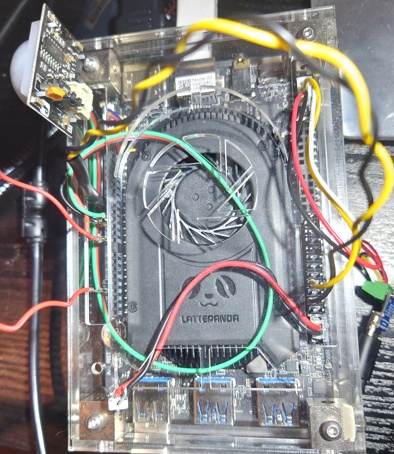
What is it? : A method to use a PIR sensor connected to MCU to wake or turn on the LattePanda
Scenario: Use a PIR motion sensor connected to the MCU to detect motion and start the CPU Turn on from OFF or Wake from Sleep if its not already running
How to use:
Here’s a detailed description of its components and functionality:
const int PIR_Pin = 0; // PIR DATA is connected to D0 via Green wire
const int pinS0 = 1; // S0 CPU state pin connected to D1 via Yellow wire
const int pinSW = 2; // SW CPU switch pin connected to D2 via Black wire
bool motionDetected = false; // State-tracking variable for motion detection
void setup() {
pinMode(LED_BUILTIN, OUTPUT);
pinMode(PIR_Pin, INPUT);
pinMode(pinSW, INPUT); // Default state, SW pin is high impedance input
pinMode(pinS0, INPUT); // Default state, S0 pin is high impedance input
Serial.begin(9600); // Initialize serial communication at 9600 bps
delay(1000); // After power up, delay for 1 second before detection
}
void startmeup() {
while (digitalRead(pinS0) == 0) { // If S0 pin is low, the board is not powered on
// Blink a "dot dot dot" pattern when S0 is LOW
dot();
dot();
dot();
pinMode(pinSW, OUTPUT); // Switch to output mode, ready to pull SW pin low
digitalWrite(pinSW, LOW); // Pull SW pin low to simulate pressing the power switch
blinkLED(LED_BUILTIN, 5, 300); // Visual feedback during the power-on process
pinMode(pinSW, INPUT); // Restore high impedance input
dash();
dash();
dash();
delay(2000); // Wait a while to let the board fully start
}
}
void dot() {
digitalWrite(LED_BUILTIN, HIGH);
delay(200); // Dot duration
digitalWrite(LED_BUILTIN, LOW);
delay(200); // Space after dot
}
void dash() {
digitalWrite(LED_BUILTIN, HIGH);
delay(600); // Dash duration
digitalWrite(LED_BUILTIN, LOW);
delay(200); // Space after dash
}
void blinkLED(int pin, int times, int speed) {
pinMode(pin, OUTPUT); // Set the LED pin as an output
for (int i = 0; i < times; i++) {
digitalWrite(pin, HIGH); // Turn the LED on
delay(speed); // Wait for the specified time
digitalWrite(pin, LOW); // Turn the LED off
delay(speed); // Wait for the specified time
}
}
void loop() {
if (digitalRead(PIR_Pin) == HIGH) {
motionDetected = true; // Update state to avoid re-sending the message
digitalWrite(LED_BUILTIN, HIGH); // Turn on LED to indicate motion
if (digitalRead(pinS0) == LOW) {
startmeup(); // Ensure the PC is powered on
}
Serial.println("MOTION DETECTED"); // Send motion detection event to the CPU
} else if (digitalRead(PIR_Pin) == LOW && motionDetected) {
motionDetected = false; // Reset state when motion stops
Serial.println("NTD"); // Send NOTHING TODO NTD motion detection event to the CPU
digitalWrite(LED_BUILTIN, LOW); // Turn off LED
}
}
Optional: Python Script Example:
/*
import serial
import time
import ctypes
def is_screen_on():
"""
Checks if the screen is awake by using Windows API to detect idle time.
Returns True if the screen is likely on; otherwise, False.
"""
class LASTINPUTINFO(ctypes.Structure):
_fields_ = [("cbSize", ctypes.c_uint), ("dwTime", ctypes.c_uint)]
lii = LASTINPUTINFO()
lii.cbSize = ctypes.sizeof(LASTINPUTINFO)
if ctypes.windll.user32.GetLastInputInfo(ctypes.byref(lii)):
current_time = ctypes.windll.kernel32.GetTickCount()
idle_time = (current_time - lii.dwTime) / 1000 # Idle time in seconds
return idle_time < 300 # If idle time is less than 5 minutes, screen is likely on
return False
def wake_up_screen():
"""
Wakes up the screen if it is off.
"""
if not is_screen_on():
# Get a handle to the console window
hWnd = ctypes.windll.kernel32.GetConsoleWindow()
# Define constants
WM_SYSCOMMAND = 0x0112
SC_MONITORPOWER = 0xF170
# Send the message to turn on the screen
ctypes.windll.user32.SendMessageW(hWnd, WM_SYSCOMMAND, SC_MONITORPOWER, -1)
print("Screen has been woken up!")
else:
print("Screen is already on.")
# Configure the serial connection
ser = serial.Serial('COM5', 9600, timeout=1) # Replace 'COM5' with your serial port
last_motion_time = time.time() # Track the last time motion was detected
motion_detected = False # Track the motion state
while True:
line = ser.readline().decode('utf-8').strip() # Read a line from the serial port
current_time = time.time() # Get the current time
if line == "MOTION DETECTED":
# Motion detected, print a message and update state
print("Motion detected by Arduino!")
last_motion_time = current_time # Update the last motion time
motion_detected = True
# Call the function to wake up the screen
wake_up_screen()
elif current_time - last_motion_time > 5: # 5 seconds of no motion
if motion_detected:
print("No motion detected...") # Notify only once when switching to no motion state
motion_detected = False
*/